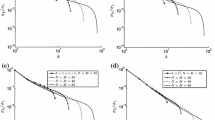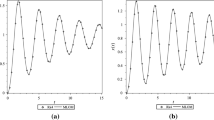Abstract
For the recovery of unknown external force in the inverse vibration problems, we first transform the linear ordinary differential equation of motion into a linear parabolic-type partial differential equation and then use the Green second identity to derive a boundary integral equation in terms of the adjoint Trefftz test functions. It results in a weak-form integral method to recover the external force for nonlinear structures, of which only the data of displacements and two velocities at initial and final times are specified. The advantages gained in this transformation to a weak-form integral formulation can be seen when we test some nonlinear inverse vibration problems within a long time span and under a large noise.






Similar content being viewed by others
References
Chen, Y., Xu, J.: Applications of the integral equation method to delay differential equations. Nonlinear Dyn. 73, 2241–2260 (2013)
Chen, Y.W.: Application of the characteristic time expansion method for estimating nonlinear restoring forces. J. Appl. Math. 2013, ID 841690, p 13 (2013)
Crawley, E.F., Aubert, A.C.: Identification of nonlinear structural elements by force-state mapping. AIAA J. 24, 155–162 (1986)
Crawley, E.F., O’Donnell, J.J.: Identification of nonlinear system parameters in joints using the force-state mapping technique. AIAA Paper 86(1013), 659–667 (1986)
Doebling, S.W., Farrar, C.R., Prime, M.B.: A summary review of vibration-based damage identification methods. Shock Vib. Dig. 30, 91–105 (1998)
Dong, L., Alotaibi, A., Mohiuddine, S.A., Atluri, S.N.: Computational methods in engineering: a variety of primal and mixed methods, with global and local interpolations, for well-posed or ill-posed BCs. CMES Comput. Model. Eng. Sci. 99, 1–85 (2014)
Duym, S., Schoukens, J., Guillaume, P.: A local restoring force surface method. Int. J. Anal. Exp. Modal Anal. 11, 116–132 (1996)
Farooq, U., Feeny, B.F.: Smooth orthogonal decomposition for modal analysis of randomly excited system. J. Sound Vib. 316, 137–146 (2008)
Feldman, M.: Consider high harmonics for identification of non-linear systems by Hilbert transform. Mech. Syst. Signal. Process. 21, 943–958 (2007)
Haykin, S., Sayed, A.H.H., Zeidler, J.R., Yee, P., Wei, P.C.: Adaptive tracking of linear time-variant systems by extended RLS algorithms. IEEE Trans. Signal Process. 45, 1118–1128 (1997)
Huang, C.H.: A generalized inverse force vibration problem for simultaneously estimating the time-dependent external forces. Appl. Math. Model. 29, 1022–1039 (2005)
Kerschen, G., Worden, K., Vakakis, A.F., Golinval, J.C.: Past, present and future of nonlinear system identification in structural dynamics. Mech. Syst. Signal. Process. 20, 505–592 (2006)
Law, G., Yong, D.: Identification of multistory shear buildings under unknown earthquake excitation using partial output measurements: numerical and experimental studies. Math. Probl. Eng. 2014, Article ID 987694, p. 10 (2014)
Liu, C.S.: Identifying time-dependent damping and stiffness functions by a simple and yet accurate method. J. Sound Vib. 318, 148–165 (2008)
Liu C.S.: Solving an inverse Sturm–Liouville problem by a Lie-group method. Bound. Value Probl. 2008, Article ID 749865, p. 18 (2008)
Liu, C.S.: An iterative GL(\(n\), R) method for solving nonlinear inverse vibration problems. Nonlinear Dyn. 74, 685–699 (2014)
Liu, C.S.: An LGDAE method to solve nonlinear Cauchy problem without initial temperature. CMES Comput. Model. Eng. Sci. 99, 371–391 (2014)
Liu, C.S., Atluri, S.N.: A fictitious time integration method for the numerical solution of the Fredholm integral equation and for numerical differentiation of noisy data, and its relation to the filter theory. CMES Comput. Model. Eng. Sci. 41, 243–261 (2009)
Liu, C.S., Chang, C.W.: A real-time Lie-group differential algebraic equations method to solve he inverse nonlinear vibration problems. Inverse Probl. Sci. Eng. (2016). doi:10.1080/17415977.2015.1130043
Ma, C.K., Tuan, P.C., Lin, D.C.: A study of inverse method for the estimation of impulse loads. Int. J. Syst. Sci. 29, 663–672 (1998)
Ma, C.K., Tuan, P.C., Chang, J.M., Lin, D.C.: Adaptive weighting inverse method for the estimation of input loads. Int. J. Syst. Sci. 34, 181–194 (2003)
Maccari, A.: Vibration amplitude control for a van der pol-Duffing oscillator with time delay. J. Sound Vib. 317, 20–29 (2008)
Masri, S.F., Chassiakos, A.G., Caughey, T.K.: Identification of nonlinear dynamic systems using neural networks. ASME J. Appl. Mech. 60, 123–133 (1993)
Namdeo, V., Manohar, C.S.: Force state maps using reproducing kernel particle method and Kriging based functional representations. CMES Comput. Model. Eng. Sci. 32, 123–159 (2008)
Ni, Y.Q., Ye, X.W., Ko, J.M.: Monitoring-based fatigue reliability assessment of steel bridges: analytical model and application. J. Struct. Eng. 136, 1563–1573 (2010)
Shiguemori, E.H., Chiwiacowsky, L.D., Campos Velho, H.F., Silva, J.D.S.: An inverse vibration problem solved by an artificial neural network. TEMA Tendencies Comput. Appl. Math. 6, 163–175 (2005)
Wei, L., Griffin, J.: The prediction of seat transmissibility from measures of seat impedance. J. Sound Vib. 214, 121–137 (1998)
Wu, A.L., Loh, C.H., Yang, J.N.: Input force identification: application to soil–pile interaction. J. Struct. Control Health Monit. 16, 223–240 (2009)
Xu, J., Chen, Y., Chung, K.W.: An improved time-delay saturation controller for suppression of nonlinear beam vibration. Nonlinear Dyn. 82, 1691–1707 (2015)
Yang, J.N., Lin, S.: On-line identification of non-linear hysteretic structures using an adaptive tracking technique. Int. J. Non Linear Mech. 39, 1481–1491 (2004)
Acknowledgments
The project NSC-102-2221-E-002-125-MY3 and the Chair Professor of Hohai University for the first author are highly appreciated.
Author information
Authors and Affiliations
Corresponding author
Rights and permissions
About this article
Cite this article
Liu, CS., Chang, JR. & Chen, YW. The recovery of external force in nonlinear system by using a weak-form integral method. Nonlinear Dyn 86, 987–998 (2016). https://doi.org/10.1007/s11071-016-2939-2
Received:
Accepted:
Published:
Issue Date:
DOI: https://doi.org/10.1007/s11071-016-2939-2




